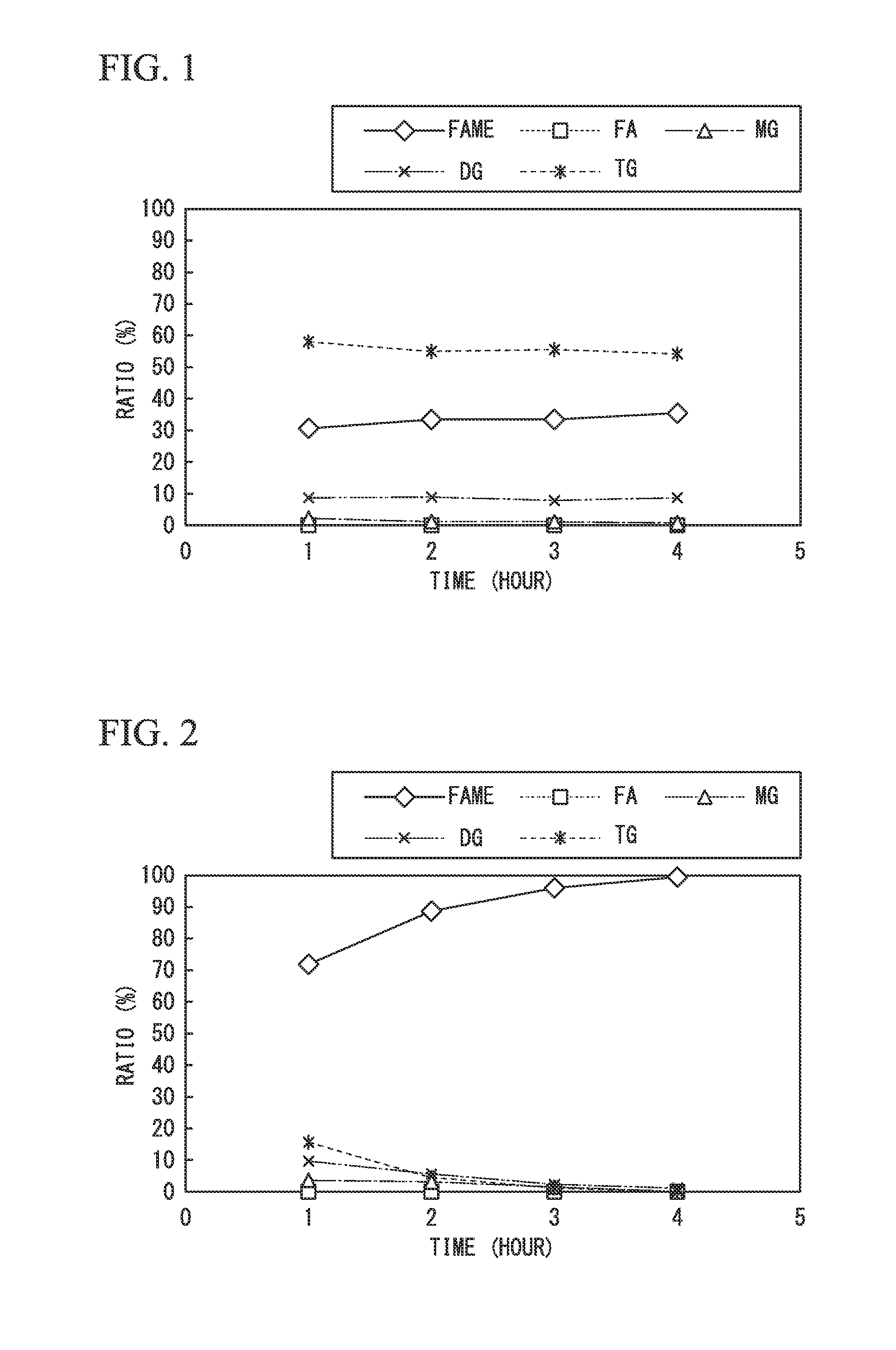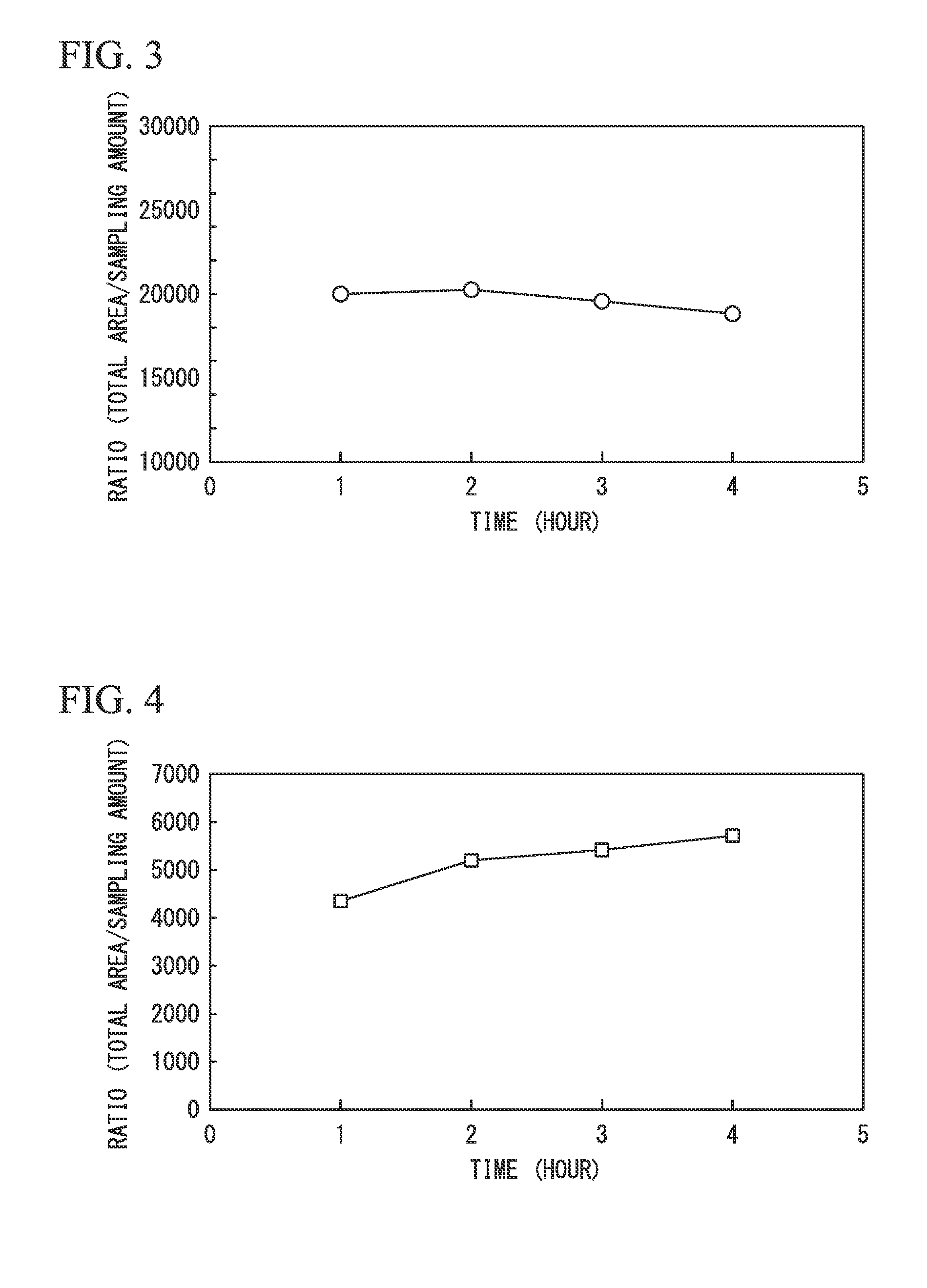Method for producing regenerated clay, regenerated clay, and method for producing purified fats and oils
a technology of regenerated clay and regenerated clay, which is applied in the field of regenerated clay, regenerated clay, and method for producing purified fats and oils, can solve the problems of undiscovered effective treatment methods, difficult to completely remove the oily ingredients present in the pores of waste clay, and difficulty in regenerating waste clay, etc., to achieve the recolorization capacity of waste clay, reduce the purchase cost of clay or the disposal cost of waste clay, and the effect of recolor
- Summary
- Abstract
- Description
- Claims
- Application Information
AI Technical Summary
Benefits of technology
Problems solved by technology
Method used
Image
Examples
example 1
[0095]Examination was made with respect to an amount of fatty acid ester of the lower alcohol, an extracted amount of the fats and oils, and the decolorization capacity of the regenerated clay, which was obtained, according to a usage ratio of the lower alcohol with respect to the waste clay.
[0096]>
[0097]First, a stirrer (POWER STIRRER AMGH (trade name), manufactured by ASH), a thermometer holder, and a glass cover were provided to a four-mouth flask. Next, waste clay that was obtained in the decolorization process of deacidified soybean oil (waste clay that was obtained after using GALLEON EARTH (trade name, manufactured by MIZUSAWA INDUSTRIAL CHEMICALS, LTD.) in a decoloriztaion process) was homogenized using a mortar, and 75 g of the waste clay, 75 g of methanol, and 1.5 g of a sulfuric acid were put into the flask.
[0098]A Dimorth cooler was connected to the flask, a temperature of a water bath was set to 75° C., and stirring was performed. A point of time at which a reflux of me...
example 2
[0127]Examination was made with respect to an amount of fatty acid ester of the lower alcohol according to a usage ratio of the lower alcohol with respect to the waste clay.
[0128]>
[0129]The reaction was carried out while collecting samples for gas chromatography in the same manner as Condition 1 except that waste clay, ethanol (having purity of 99.5% or higher), and sulfuric acid in amounts shown in Table 4 were used, and weights of a solid portion and a liquid portion were measured. Results are shown in Table 4.
[0130]Peaks that were obtained by the gas chromatography were classified into fatty acid ethyl ester (FAEE), free fatty acid (FA), monoglyceride (MG), diglyceride (DG), and triglyceride (TG), respectively. Then, each compositional ratio was calculated from a ratio of each peak area with respect to the total peak area. Results of Condition 1 are shown in Table 5 and FIG. 7, results of Condition 2 are shown in Table 6 and FIG. 8, results of Condition 3 are shown in Table 7 and...
example 3
[0133]Examination was made with respect to a usage ratio of the lower alcohol with respect to the waste clay and a reaction time by using ethanol as the lower alcohol.
[0134]First, the stirrer (POWER STIRRER AMGH (trade name), manufactured by Asahi Rika Seisakusho Co., Ltd.), the thermometer holder, and the glass cover were provided to a four-mouth flask. Next, waste clay that was obtained in the decolorization process of deacidified soybean oil (waste clay that was obtained after using GALLEON EARTH (trade name, manufactured by MIZUSAWA INDUSTRIAL CHEMICALS, LTD.) in a decoloriztaion process) was homogenized using a mortar. A moisture content of the homogenized waste clay was 6.8%, and oily ingredients that were obtained by a Soxhlet extraction method (ether) was 28.3%.
[0135]Waste clay, ethanol (having purity of 99.5% or higher), and sulfuric acid in amounts shown in Table 9 were put into the flask. Then, a Dimorth cooler was connected to the flask, a temperature of an oil bath was ...
PUM
| Property | Measurement | Unit |
|---|---|---|
| temperature | aaaaa | aaaaa |
| cell length | aaaaa | aaaaa |
| pH | aaaaa | aaaaa |
Abstract
Description
Claims
Application Information
 Login to View More
Login to View More - R&D
- Intellectual Property
- Life Sciences
- Materials
- Tech Scout
- Unparalleled Data Quality
- Higher Quality Content
- 60% Fewer Hallucinations
Browse by: Latest US Patents, China's latest patents, Technical Efficacy Thesaurus, Application Domain, Technology Topic, Popular Technical Reports.
© 2025 PatSnap. All rights reserved.Legal|Privacy policy|Modern Slavery Act Transparency Statement|Sitemap|About US| Contact US: help@patsnap.com



